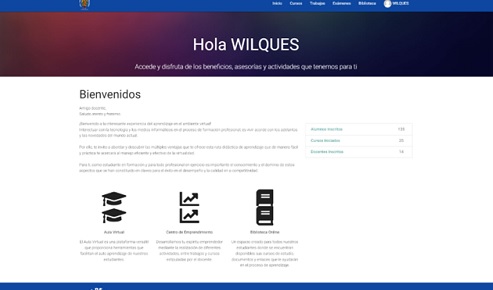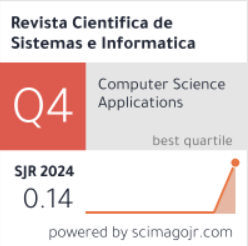Implementation of a virtual classroom to improve the satisfaction of high school students in a Peruvian educational institution
DOI:
https://doi.org/10.51252/rcsi.v3i1.474Keywords:
COVID-19, distance education, digital resources, ICTAbstract
The satisfaction of students about distance education is important and focused on the idea that information and communication technologies (ICT) are valuable and didactic resources for teaching-learning different from the traditional one, aligned with the bicentennial plan of the Ministry of Education. This research proposed to implement a virtual classroom and improve the academic satisfaction of the students of the 5th year of the I.E.I. Virgen de Guadalupe, Banda de Shilcayo, Perú. A pre-experimental type design was used with a sample of 42 students, to whom two Likert-type instruments were applied. Among the results we can specify that the initial satisfaction of the students was medium in 50% and low in 36%, later 71% qualified the virtual classroom as adequate, that, after its implementation, 86% of students presented high levels of satisfaction. It is concluded that the implementation of a virtual classroom will significantly improve the academic satisfaction of high school students in a Peruvian educational institution.
Downloads
References
Acosta Álvarez, C. L., Ortega González, D., & Díaz Cruz, Y. (2020). Educación presencial con mediación virtual: una experiencia de Honduras en tiempos de la COVID-19. Revista Digital de Investigación en Docencia Universitaria, 14(2), e1229. https://doi.org/10.19083/10.19083/ridu.2020.1229
Acuña Jimenez, A. M. (2020). Satisfacción en el uso de entornos virtuales de aprendizaje en estudiantes de 5° de Secundaria de dos Instituciones Educativas, Lima [Universidad César Vallejo]. https://hdl.handle.net/20.500.12692/54867
Crawford, A. R. (2016). Experiencia de aprendizaje en línea. Ashlee Crawford Electronic Portfolio. http://acrawf41.weebly.com/21-content-standards--student-technology-standards.html
Flores Ferro, E., Gutiérrez, N., Añasco, N., González, M., Villafaña, L., Gonzáles Flores, P., & Maureira Cid, F. (2021). Satisfacción de las clases online de estudiantes de educación física de una Universidad de Chile en tiempos de pandemia. EmásF: Revista Digital de Educación Física, 12(69), 10–19. https://emasf.webcindario.com/Satisfaccion_de_las_clases_online_por_parte_de_estudiantes_de_EF_de_una universidad_de_Chile.pdf
González-Hernández, L. (2019). El Aula Virtual como Herramienta para aumentar el Grado de Satisfacción en el Aprendizaje de las Matemáticas. Información Tecnológica, 30(1), 203–214. https://doi.org/10.4067/S0718-07642019000100203
Hernández-Sampieri, R., & Mendoza Torres, C. P. (2018). Metodología de la investigación: Las rutas cuantitativa, cualitativa y mixta (1st ed.). Edamsa Impresiones, S.A de C. V.
Londoño Guerra, S. J., & Serna Fonseca, J. L. (2018). Un aula virtual de aprendizaje para potencializar el uso y apropiación de las tic en los estudiantes del grado sexto de la institución educativa rural Carlos González del municipio de Belmira y la institución educativa américa del municipio de Medellín. [Universidad Cooperativa de Colombia]. https://repository.ucc.edu.co/handle/20.500.12494/7010
Monarca, H. (2018). Calidad de la Educación en Iberoamérica: Discursos, políticas y prácticas. Dykinson, S.L. https://www.dykinson.com/cart/download/ebooks/8765/
Monje Álvarez, C. A. (2011). Metodología de la investigación cuantitativa y cualitativa. Guía didáctica. (1st ed.). Universidad Surcolombiana. https://www.uv.mx/rmipe/files/2017/02/Guia-didactica-metodologia-de-la-investigacion.pdf
Pareja Chau, F. M., & Paz Flores, C. A. (2020). La satisfacción de la educación virtual, en la modalidad pregrado de una universidad privada, en la ciudad de Lima, durante el 2019 [Universidad Privada del Norte]. https://hdl.handle.net/11537/25463
Pupiales, J. (2020). Educación virtual, entre la desigualdad y la aceptación en América Latina. France 24. https://www.france24.com/es/20200515-educacion-virtual-desigualdad-america-latina
Soto Mauricio, K. A. (2020). Educación virtual y satisfacción de las estudiantes del 5° año de la Institución Educativa Nacional Santa Rosa, año 2020 [Universidad Cesar Vallejo]. https://hdl.handle.net/20.500.12692/46623
Surdez Pérez, E. G., Sandoval Caraveo, M. del C., & Lamoyi, C. L. (2018). Satisfacción estudiantil en la valoración de la calidad educativa universitaria. Educación y Educadores, 21(1), 9–26. https://doi.org/10.5294/edu.2018.21.1.1
Torres Acurio, E. (2020). Implementación de un aula virtual Moodle 3.8 en tiempos de COVID-19 para la I.E.P. María Jesús [Universidad Peruana Unión]. http://hdl.handle.net/20.500.12840/4306
UNESCO. (2020). Informe CEPAL, OREALC y UNESCO: “La educación en tiempos de la pandemia de COVID-19.” Organización de Las Naciones Unidas Para La Educación, La Ciencia y La Cultura. https://www.iesalc.unesco.org/2020/08/25/informe-cepal-y-unesco-la-educacion-en-tiempos-de-la-pandemia-de-covid-19/
Vargas Cordero, Z. R. (2009). La Investigación aplicada: Una forma de conocer las realidades con evidencia científica. Revista Educación, 33(1), 155. https://doi.org/10.15517/revedu.v33i1.538

Published
How to Cite
Issue
Section
License
Copyright (c) 2023 Erick Johann Saldaña-Cerván

This work is licensed under a Creative Commons Attribution 4.0 International License.
The authors retain their rights:
a. The authors retain their trademark and patent rights, as well as any process or procedure described in the article.
b. The authors retain the right to share, copy, distribute, execute and publicly communicate the article published in the Revista Científica de Sistemas e Informática (RCSI) (for example, place it in an institutional repository or publish it in a book), with an acknowledgment of its initial publication in the RCSI.
c. Authors retain the right to make a subsequent publication of their work, to use the article or any part of it (for example: a compilation of their works, notes for conferences, thesis, or for a book), provided that they indicate the source of publication (authors of the work, journal, volume, number and date).









